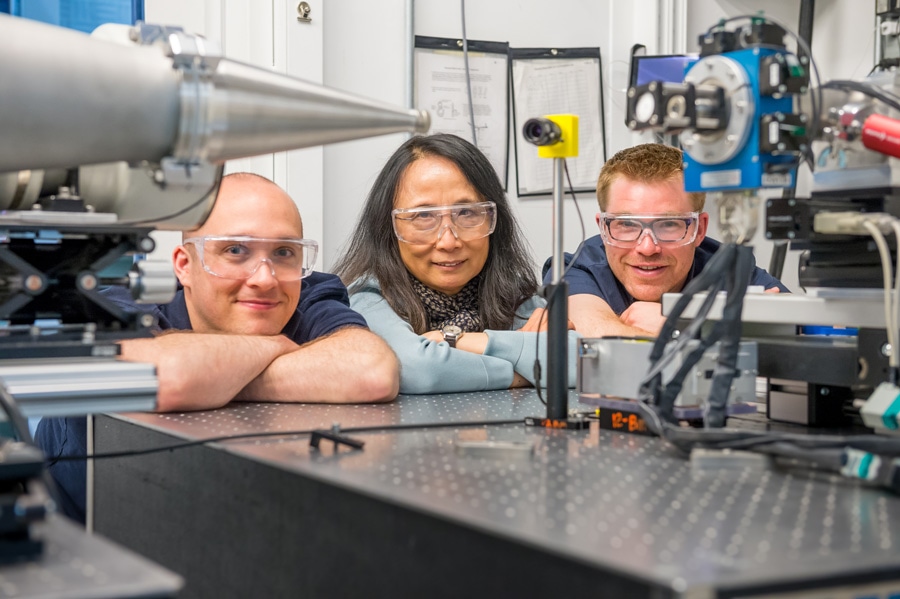Jun 5 2017
Scientists can use the unlimited energy of the sun to make a clean fuel by splitting a water molecule into two atoms of hydrogen and one of oxygen. For the very first time, in a new study from the U.S. Department of Energy’s (DOE) Argonne National Laboratory and Harvard University, scientists have been able to see a very important step in the water-splitting process, which is considered to be one step closer to providing abundant solar energy for all.
 Argonne Chemists Dugan Hayes, Lin Chen, and Ryan Hadt have identified a rapid electronic process that could aid the water-splitting reaction in cobalt-containing catalysts. Cobalt catalysts are relatively inexpensive and could replace more expensive precious metal catalysts in the production of clean energy, most notably solar fuels. (Image by Argonne National Laboratory.)
Argonne Chemists Dugan Hayes, Lin Chen, and Ryan Hadt have identified a rapid electronic process that could aid the water-splitting reaction in cobalt-containing catalysts. Cobalt catalysts are relatively inexpensive and could replace more expensive precious metal catalysts in the production of clean energy, most notably solar fuels. (Image by Argonne National Laboratory.)
Splitting a water molecule needs a metal catalyst to get the reaction going. Recently, an increased amount of scientific attention focused on cobalt, a comparatively inexpensive and abundant catalyst that is capable of serving as an escort to an electronic dance between hydrogens and oxygens in the right circumstances.
Cobalt oxygen-evolving catalysts are the active components in technologies like artificial leaves and other materials in which you can harvest light to drive the synthesis of solar fuels.
Ryan Hadt, Argonne Postdoctoral Researcher and a Co-first Author of the study
The overall water-splitting reaction in fact has two halves. The Researchers concentrated on the first half, known as water oxidation, which needs the transfer of four electrons and four protons and then eventually leads to the formation of an oxygen-oxygen bond. The oxygens require a temporary dance partner, played by the cobalt catalyst, for this process.
This reason has still not been well understood because the transfers and the formation of the bond take place in a flash – the entire process takes less than a billionth of a second. In order to comprehend the nuances of the bonding action, the Researchers had to carry out X-ray absorption spectroscopy measurements at Argonne’s Advanced Photon Source.
The Researchers concentrated on a particularly intriguing chemical twist in their analysis. During the start of the process, a bridge of two oxygen atoms joins two cobalt ions. In turn, each of the cobalt ions get connected to their own water molecule. Things seem to be pretty stable at this point.
The electronic dance is ready to start when a cobalt ion adds an extra positive charge, temporarily increasing a characteristic number that Scientists call as an “oxidation state.” The oxidation state changes for an instant, from three to four, in the case of cobalt.
The process begins in earnest when two cobalt ions with an oxidation state of four come into contact. The charge transfers result in the dissociating of the hydrogen atoms of the water molecules from their oxygen bonds, leaving behind the cobalt atoms bonded only to oxygen ions.
This is instantly followed by the key moment, when each cobalt center receives electrons from the newly exposed oxygen atoms. When this takes place, a bond is developed between the two oxygens, producing a molecular intermediate stage called a peroxide, which is capable of being rapidly oxidized in order to release a dioxygen molecule. Solar fuels can be made by the electrons obtained from water during this process.
The Researchers used the Advanced Photon Source, a DOE Office of Science User Facility, to directly measure cobalt oxidation states and then employ theory to determine a quantity called “exchange coupling,” a quantum mechanical value that helps in identifying the relationship between the spins of the electrons that are transported between the oxygen and cobalt atoms. The Researchers discovered that these electrons spins are in opposite directions – in scientific jargon, they are antiferromagnetically coupled.
Antiferromagnetism plays an important role in the formation of the oxygen-oxygen bond, as it provides a way to simultaneously transfer two electrons to make a chemical bond.
Ryan Hadt, Argonne Postdoctoral Researcher and a Co-first Author of the study
Dugan Hayes, Argonne Postdoctoral Researcher and Study Author, also pointed to the unique capability of the Advanced Photon Source to resolve the location of the extra-oxidized cobalt atoms. “Essentially, it allows you to have a focused snapshot, as opposed to just seeing a chemical blur,” he said. “It’s important that we determine the characteristics of the catalyst on the timescale the electrons are moving.”
The March 27th edition of the Proceedings of the National Academy of Sciences published a paper based on the research, “In situ characterization of cofacial Co(IV) centers in Co4O4 cubane: Modeling the high-valent active site in oxygen-evolving catalysts.”
DOE’s Office of Science funded the research. Other Authors of the study include Argonne’s Lin Chen and Benjamin Reinhardt and several members of the Nocera group at Harvard University.